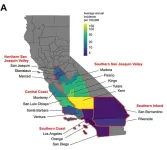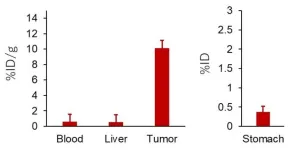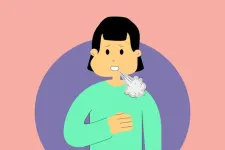(Press-News.org) Valley fever is an emerging fungal disease in the western United States that most often causes flu-like symptoms, but can also cause dangerous or even deadly complications. By analyzing data on reported cases of Valley fever in California, which have increased dramatically over the last two decades, researchers from University of California San Diego and University of California, Berkeley, have identified seasonal patterns that could help individuals and public health officials better prepare for future surges in Valley fever cases. The findings also have important implications for how the changing climate can exacerbate the threat of infectious diseases. The findings are published in The Lancet Regional Health - Americas.
The researchers collaborated closely with the California Department of Health (CDPH) to analyze all reported Valley fever cases in California from 2000 to 2021. By comparing these to seasonal climate data, they discovered how the disease cycles seasonally across different California counties and identified how these cycles are influenced by drought periods. The researchers found that while most cases occur during the period from September to November, there were differences in seasonal patterns and timing between counties and years.
“Most seasonal infectious diseases show a peak in cases every year, so we were surprised to see that there were certain years during which few or no counties had a seasonal peak in Valley fever cases,” said first author Alexandra Heaney, Ph.D., assistant professor at the UC San Diego Herbert Wertheim School of Public Health and Human Longevity Science. “This made us wonder what was driving these differences in seasonality between years, and based on the timing we observed, we hypothesized that drought might be playing a role.”
The researchers found that on average, counties in the San Joaquin Valley and Central Coast regions had the most pronounced seasonal peaks, though the peaks started earlier in San Joaquin Valley.
“This is valuable information to time public health messaging aimed at educating the public about the symptoms of Valley fever and how to protect themselves,” added Heaney.
Valley fever is caused by spores from the soil-dwelling Coccidioides fungus. People contract Valley fever by inhaling infectious spores that become aerosolized when the soil is disturbed by wind or human activity. Valley fever is most likely to affect people who are exposed to airborne dust frequently, including those who work outdoors. However, the disease is not contagious.
Valley fever has long been a problem in the American Southwest, but the number of cases has skyrocketed in recent years, tripling from 2014–2018 and again from 2018–2022, according to the CDPH. However, because it is still relatively rare, and because it causes similar symptoms to other respiratory infections, including COVID-19, Valley fever is often misdiagnosed. When left untreated, the fungus can cause severe damage to the respiratory system and spread to other parts of the body, such as the skin, bones and even the brain, the latter of which can be deadly.
“Knowing when the Valley fever season starts and how intense it will be can help health care practitioners know when they should be on high alert for new cases,” said corresponding author Justin Remais, Ph.D., professor at UC Berkeley School of Public Health. “This is the first study to pin down exactly when disease risk is highest in all of California’s endemic counties, as well as places where the disease is newly emerging.”
The researchers observed that during drought periods, seasonal peaks in Valley fever cases are less severe. However, when the rains return, these peaks are particularly high. One hypothesis to explain this pattern is that droughts allow heat-resistant Coccidioides spores to outlast their less-hardy competitors. When rains return, the fungus is able to proliferate widely with less competition for moisture and nutrients.
Another hypothesis suggests that the links between Valley fever and drought may be due to drought’s impact on rodents that host the Coccidioides fungus. Because rodent populations decline during droughts, and because dead rodents are thought to be an important source of nutrients for the fungus, it may be able to survive and spread more easily in drought conditions.
“This work is an important example of how infectious diseases are influenced by climate conditions,” said Heaney. “Even though droughts appear to decrease Valley fever cases in the short term, the net effect is an increase in cases over time, particularly as we experience more frequent and severe droughts due to climate change.”
Individuals can help protect themselves against Valley fever during dry and dusty periods by minimizing time outdoors and wearing face coverings that can block dust. The researchers also emphasize the need for more thorough monitoring of the Valley fever fungus, which can be difficult to detect.
The team is now expanding the range of their analyses to include other Valley fever hotspots in the United States.
“Arizona is much dustier than California and has very different climate dynamics, and about two thirds of cases in the United States occur in Arizona, so that’s where we’re looking next,” said Heaney. “Understanding where, when, and in what conditions Valley fever is most prevalent is critical for public health officials, physicians, and the public to take precautions during periods of increased risk.”
Full link to study: https://www.thelancet.com/journals/lanam/article/PIIS2667-193X(24)00191-1/fulltext
Additional co-authors on the study include Simon K. Camponuri, Phil Collender, Amanda Weaver and John Taylor at UC Berkeley; Jennifer R. Head at University of Michigan; Gail Sondermeyer-Cooksey, Alexander Yu, Duc Vugia and Seema Jain at California Department of Public Health and Abinash Bhattachan at Texas Tech University.
This study was funded by the National Institutes of Health (grant R01AI148336).
# # #
END
Dangerous airborne fungus boosted by California droughts
Valley fever cases peak from September to November; drought temporarily dampens these peaks, but leads to bigger surges once rain returns
2024-09-03
ELSE PRESS RELEASES FROM THIS DATE:
$1.8 million NIH grant to FAU engineering fuels quest to decode human evolution
2024-09-03
Natural selection is an important evolutionary force that enables humans to adapt to new environments and fight disease-causing pathogens. However, the unique footprints of natural selection in our genome can be buried beneath those left by other evolutionary forces. Thus, by leveraging information about multiple evolutionary forces, researchers can identify signatures of natural selection in the human genome, and ultimately determine its role in human adaptation and disease.
Low-cost DNA sequencing has ...
Communication helps parent relationships with new college students but has limits
2024-09-03
PULLMAN, Wash. -- When young adults first go off to college, more communication with parents generally leads to better relationships, but parents should avoid always initiating it, according to a study led by Washington State University researchers.
In a paper published in the journal Emerging Adulthood, WSU Assistant Professor Jennifer Duckworth and co-authors found that phone, text, video or in-person communication made first-year students feel better about the relationship with their parents. Students also felt better about the relationship when parents offered support or advice, and when they discussed important topics, such as studying and friendships. However, researchers found ...
Natural selection may create inter-species exploitation
2024-09-03
A modeling study suggests that one-sided interspecies cooperation can spontaneously emerge and persist over time, despite only one species benefitting. Evolutionary game theory, and the prisoner’s dilemma in particular, are often used to model the evolution of cooperation within a single species. In the prisoner’s dilemma, both parties benefit by cooperating, but the greatest benefit is earned by a defector who plays with a cooperator. The temptation to cheat tends to push players towards defection, ...
Targeted cancer therapies: Getting radioactive atoms to accumulate in tumors
2024-09-03
Prostate cancer is the second most common cancer among men worldwide, following lung cancer. In the United States alone, nearly 300,000 new cases are diagnosed annually. While reducing testosterone and other male hormones can be an effective treatment for prostate cancer, this approach becomes ineffective once the disease progresses to metastatic castration-resistant prostate cancer (mCRPC). At this stage, the cancer advances quickly and becomes resistant to conventional hormonal therapies and chemotherapy.
A clever strategy for fighting mCRPC is to exploit the ...
Gigantic asteroid impact shifted the axis of Solar System's biggest moon
2024-09-03
Around 4 billion years ago, an asteroid hit the Jupiter moon Ganymede. Now, a Kobe University researcher realized that the Solar System's biggest moon's axis has shifted as a result of the impact, which confirmed that the asteroid was around 20 times larger than the one that ended the age of the dinosaurs on Earth, and caused one of the biggest impacts with clear traces in the Solar System.
Ganymede is the largest moon in the Solar System, bigger even than the planet Mercury, and is also interesting for the liquid water oceans beneath its icy surface. Like the Earth’s moon, it is tidally locked, meaning that it always shows the ...
Finger wrap uses sweat to provide health monitoring at your fingertips—literally
2024-09-03
A sweat-powered wearable has the potential to make continuous, personalized health monitoring as effortless as wearing a Band-Aid. Engineers at the University of California San Diego have developed an electronic finger wrap that monitors vital chemical levels—such as glucose, vitamins, and even drugs—present in the same fingertip sweat from which it derives its energy.
The advance was published Sept. 3 in Nature Electronics by the research group of Joseph Wang, a professor in the Aiiso Yufeng Li Family Department of Chemical and Nano Engineering ...
Large sharks may be hunting each other – and scientists know because of a swallowed tracking tag
2024-09-03
Who killed the pregnant porbeagle?
In a marine science version of the game Cluedo, researchers from the US have now accused a larger shark, with its deciduous triangular teeth, in the open sea southwest of Bermuda. This scientific whodunnit is published in Frontiers in Marine Science.
“This is the first documented predation event of a porbeagle shark anywhere in the world,” said lead author Dr Brooke Anderson, a former graduate student at Arizona State University.
“In one event, the population not only lost a reproductive female that could contribute to population growth, but it also lost all her developing ...
Can’t stop belching? Dietary habits or disease could be the reason
2024-09-03
Belching is a common bodily function, but when it escalates to a level that interferes with daily life, it is defined as belching disorders. International surveys have reported that approximately 1% of adults have belching disorders, but the percentage in Japan and the factors involved often elude medical professionals.
To examine the relationship between the rate of belching disorders, comorbidities, and lifestyles in Japan, a research team led by Professor Yasuhiro Fujiwara of Osaka Metropolitan University’s Graduate School of Medicine ...
Exploring peptide clumping for improved drug and material solutions
2024-09-03
Scientists from China have investigated how short peptide chains aggregate together in order to deepen our understanding of the process, which is crucial for drug stability and material development. Their study, published in JACS Au, provides valuable insights into how short proteins called peptides interact, fold, and function. These findings have significant implications for medicine, material science, and biotechnology.
Peptides are short chains of amino acids that play essential roles in the body by building structures, speeding up chemical reactions, and supporting our immune system. The specific function of a protein is determined by how its amino acids interact with each other and ...
Young adults let down by ‘postcode lottery’ for ADHD treatment - national survey
2024-09-03
A national survey conducted as part of University of Exeter research has found huge variation in treatment for ADHD, highlighting the struggle many young adults face once they turn 18.
Researchers have warned that the current system is failing many young adults as they transition from children’s to adult’s services - suddenly finding themselves unable to access treatment because services do not link up effectively.
More than 750 people from across the country – including commissioners, healthcare professionals working ...
LAST 30 PRESS RELEASES:
What causes some people’s gut microbes to produce high alcohol levels?
Global study reveals widespread burning of plastic for heating and cooking
MIT study shows pills that communicate from the stomach could improve medication adherence
Searching for the centromere: diversity in pathways key for cell division
Behind nature’s blueprints
Researchers search for why some people’s gut microbes produce high alcohol levels
Researchers find promising new way to boost the immune response to cancer
Coffee as a staining agent substitute in electron microscopy
Revealing the diversity of olfactory receptors in hagfish and its implications for early vertebrate evolution
Development of an ultrasonic sensor capable of cuffless, non-invasive blood pressure measurement
Longer treatment with medications for opioid use disorder is associated with greater probability of survival
Strategy over morality can help conservation campaigns reduce ivory demand, research shows
Rising temperatures reshape microbial carbon cycling during animal carcass decomposition in water
Achieving ultra-low-power explosive jumps via locust bio-hybrid muscle actuators
Plant-derived phenolic acids revive the power of tetracycline against drug-resistant bacteria
Cooperation: A costly affair in bacterial social behaviour?
Viruses in wastewater: Silent drivers of pollution removal and antibiotic resistance
Sub-iethal water disinfection may accelerate the spread of antibiotic resistance
Three in four new Australian moms struggle with body image
Post-stroke injection protects the brain in preclinical study
Cardiovascular risk score predicts multiple eye diseases
Health: estimated one in ten British adults used or interested in GLP-1 medications for weight loss
Exercise to treat depression yields similar results to therapy
Whooping cough vaccination for pregnant women strengthens babies’ immune system
Dramatic decline in new cases of orphanhood in Uganda driven by HIV treatment and prevention programs
Stopping weight loss drugs linked to weight regain and reversal of heart health markers
Higher intake of food preservatives linked to increased cancer risk
Mass General Brigham–developed cholera vaccine completes phase 1 trial
First experimental validation of a “150-year-old chemical common sense” direct visualization of the molecular structural changes in the ultrafast anthracene [4+4] photocycloaddition reaction
Lack of support for people on weight loss drugs leaves them vulnerable to nutritional deficiencies, say experts
[Press-News.org] Dangerous airborne fungus boosted by California droughtsValley fever cases peak from September to November; drought temporarily dampens these peaks, but leads to bigger surges once rain returns







